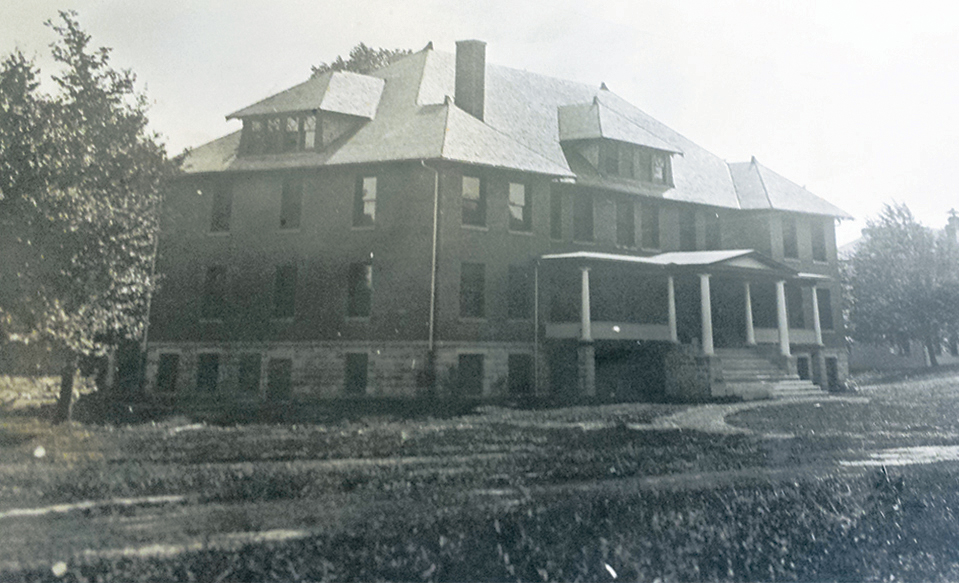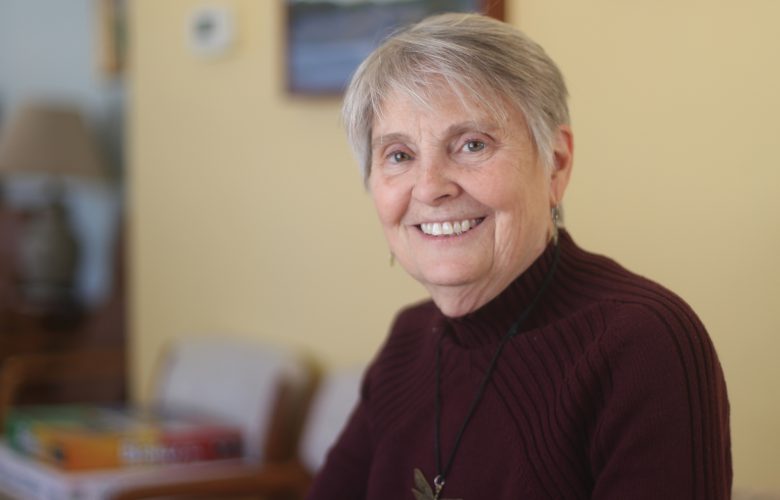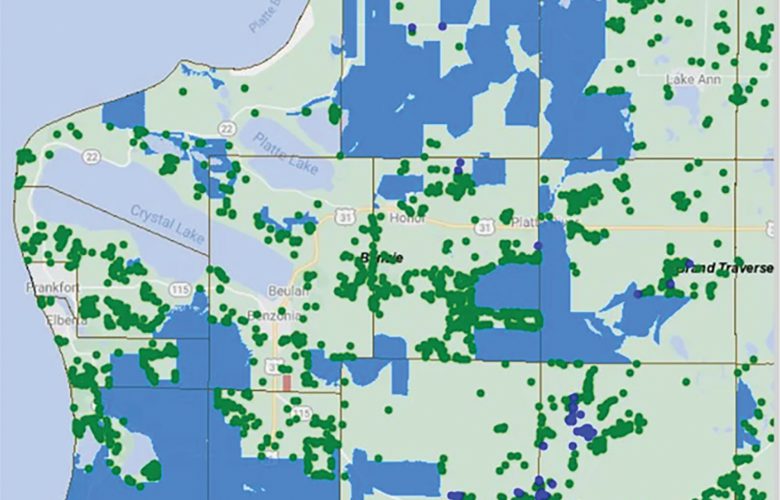More than a century of the Mills Community House
By Staff Reports
A center of our community for more than 100 years, the Mills Community House was established in 1909 and named for the beloved Reverend Harlow S. Mills. In 1972, the building was placed on the National Register of Historic Places. Since 2002, the Mills Community Association is a 501(c)3 nonprofit that is supported by donations, rentals, and fundraising events—not your tax dollars.
But the story of the beautiful brick building on top of Benzonia hill began even earlier. Most locals know that the building was once a college, funded by a group of self-proclaimed “ardent educators” from Oberlin College who settled at the east end of Crystal Lake in 1858. A model of progressive thinking, Benzonia Academy was to be “an institution dedicated to the education of both sexes, without distinction of color or ethnic origin” and with an emphasis on art and music. That vision has endured to this day.
The foundation of the Mills Community House began in 1858, when the Reverend Charles E. Bailey and four families from his Congregational parish in Oberlin, Ohio, founded Benzonia. Modeled after earlier Congregational settlements, it was to be an “educational Christian colony” in what was then a remote wilderness.
Classes were held in a private home from 1860 until the buildings were constructed in 1863. Within five years, the initial two-story frame building burned, and the school took over a three-story frame building, dubbing it “East Hall.” This was the only building used by the college for a number of years, until the 1890s, when a new building was constructed and East Hall was turned into the girl’s dormitory, dining room, and president’s quarters.
As an integral part of the new community, Grand Traverse College was chartered in 1863. Dedicated to educating both sexes and people of all colors and ethnic origin, it provided college preparatory work and teacher training. Enrollment rose from 13 in the first graduating class to a peak of 150 in 1875. The school reorganized in 1891 as Benzonia College, supplying college-level education until 1900, when it became Benzonia Academy. Both the college and the academy served as a center for cultural and recreational activities for citizens of the surrounding villages. Benzonia Academy provided an education deep in music and arts, for approximately $2.75 per week, including room and board.
In 1906, George Catton became headmaster of Benzonia Academy and his family—including son Bruce, future alumnus of the Academy and later a Pulitzer Prize-winning historian—lived on the main floor of the women’s dormitory. (Bruce later wrote Waiting for the Morning Train, a memoir of his life in Benzonia.)
In January 1909, East Hall was destroyed by fire; fortunately, there were no injuries. The Mills Cottage, a distinctive red brick building, was built as a replacement, re-opening in October. It was named for Reverend Harlow S. Mills, who led the local Congregationalist congregation from 1896 to 1916 and made substantial contributions to the construction of the building in honor of his late wife—notably, after the 1909 fire, he managed to rally the community to raise $2,200 for the new structure; a wealthy Manistee lumber baron matched the funds, stipulating that the new building be constructed of brick, not wood; and funding for the eventual total cost of $12,000 was spearheaded by Reverend Mills, who himself made a generous donation as a memorial to his late wife, Mary Fisher Mills.
Changing conditions—including improved transportation and expanded availability of public schools—resulted in declining attendance, however.
In 1918, Benzonia Academy closed with a graduating class of 10. For 55 years, the college and academy had fulfilled the founders’ dream of bringing co-educational opportunities to Northern Michigan. (Can you imagine if it had continued, in much the same way that Christian-founded colleges of the same era downstate had continued: think Kalamazoo College, Alma College, Albion College, etc.)
The building was deeded to the Benzonia Congregational Church, with the proviso that it be used for cultural, educational, and outdoor activities for the community.
After a renovation that included an auditorium and gymnasium on the upper level and a meeting space in the lower level/walkout basement, the building reopened in 1925 as Mills Community House, which became home to the public library—Benzie County’s first—which remains there to this day, nearly a century later. (Prior to being housed at the Mills, the library had “floated around” the community in private homes for many years, as did many other area libraries. The Benzonia Public Library as we know it today, however, was the first “officially established” library in Benzie County, meaning it was the first to have normal operating hours and staff dating back to 1925, according to Lou Yock, previously the director of the Benzie Area Historical Museum.)
During the 1930s, the top floor was used as a gymnasium, theater, and dance floor for nearby Benzonia High School. When the high school built its own gymnasium—as part of a Works Progress Administration (WPA) project, part of President Franklin D. Roosevelt’s (D) “New Deal” to employ millions of jobseekers during the Great Depression to carry out public works projects, including the construction of public buildings and roads—the community continued using the space for plays, parties, and meetings.
During World War II, young women from southern Michigan arrived to work on nearby farms as part of the Women’s Land Army. The Mills House was, again, put into service as a dormitory for these temporary workers, who were assisting their country while male workers were serving in the U.S. Armed Forces.
The three-story Mills Community House is the only remaining building from the Benzonia Academy. Supporters successfully placed the Mills on the National Register of Historic Places in 1972. Over the years, the building became dated, and the top floor was closed, due to safety concerns. The community continued to appreciate the building, especially the ongoing services of the Benzonia Public Library on the main floor and the availability of meeting space on the lower level/basement.
The Benzonia Public Library is still on the main floor, which has a section for children and young adults, bound volumes of Benzie newspapers dating back to 1888, tapes and audiobooks, several computers, and even a list of the core library that had belonged to the original school. The atmosphere is both modern and cozy but also a trip into the past—after all, Bruce Catton, our native son and Pulitzer Prize winner, slept here. The Catton Room contains the complete collection of Bruce’s books. Library director Amanda McClaren will be happy to show you around.
A generous donation from Cecily Williams in the 1990s expanded the Mills House’s ability to serve as a community center. A full kitchen and new restrooms were added to the lower level meeting space, and the room was refurbished with new lighting and other amenities. Even though the third floor/upper level auditorium was not in use back then, Williams’ foresight in having an elevator for all levels made it possible to re-open the top floor in 2008, after two years of renovations—the upper level was converted into a small recital and lecture hall, now home to the Benzie County Players.
The building underwent further visible renovations in 2014, most evident in a stair-tower addition and expanded parking area—gone is the struggle to find a space. The upper hall benefited from a sound booth area, interior paint, window and stage curtain enhancements, and “blackout blinds” (no more glare). Not to mention air conditioning and comfortable chairs.
The library on the main floor was renovated in 2015—hardwood floors were refinished and upgrades to heating, air conditioning, lighting, and painting were completed in 2018.
The Mills Community House Association—formed in 2002—is a 501(c)3 nonprofit and receives no taxpayer funding; operating costs are supported by a small endowment fund, modest rental rates, and tax-deductible contributions from donors. In addition to private rentals for anniversaries, graduations, meetings, and weddings, the Mills Hall has been home to a variety of events, including performances by the Benzie County Community Chorus and the Benzie County Players, as well as the Benzie Area Historical Society’s lecture series and a number of author programs.
The Mills Community House is still a vibrant part of the community, thanks to the vision of the founders and others who have helped to preserve this valuable piece of history.
This article is an amalgamation of some history on the Mills Community House’s website, as well as an article by Susan Koenig that was first published in The Betsie Current back in July 2014 and another article about the library in July 2015.
Photo Caption: Photo courtesy of Mills Community Association.





Amazing! Let’s recreate Benzonia College/Academy!